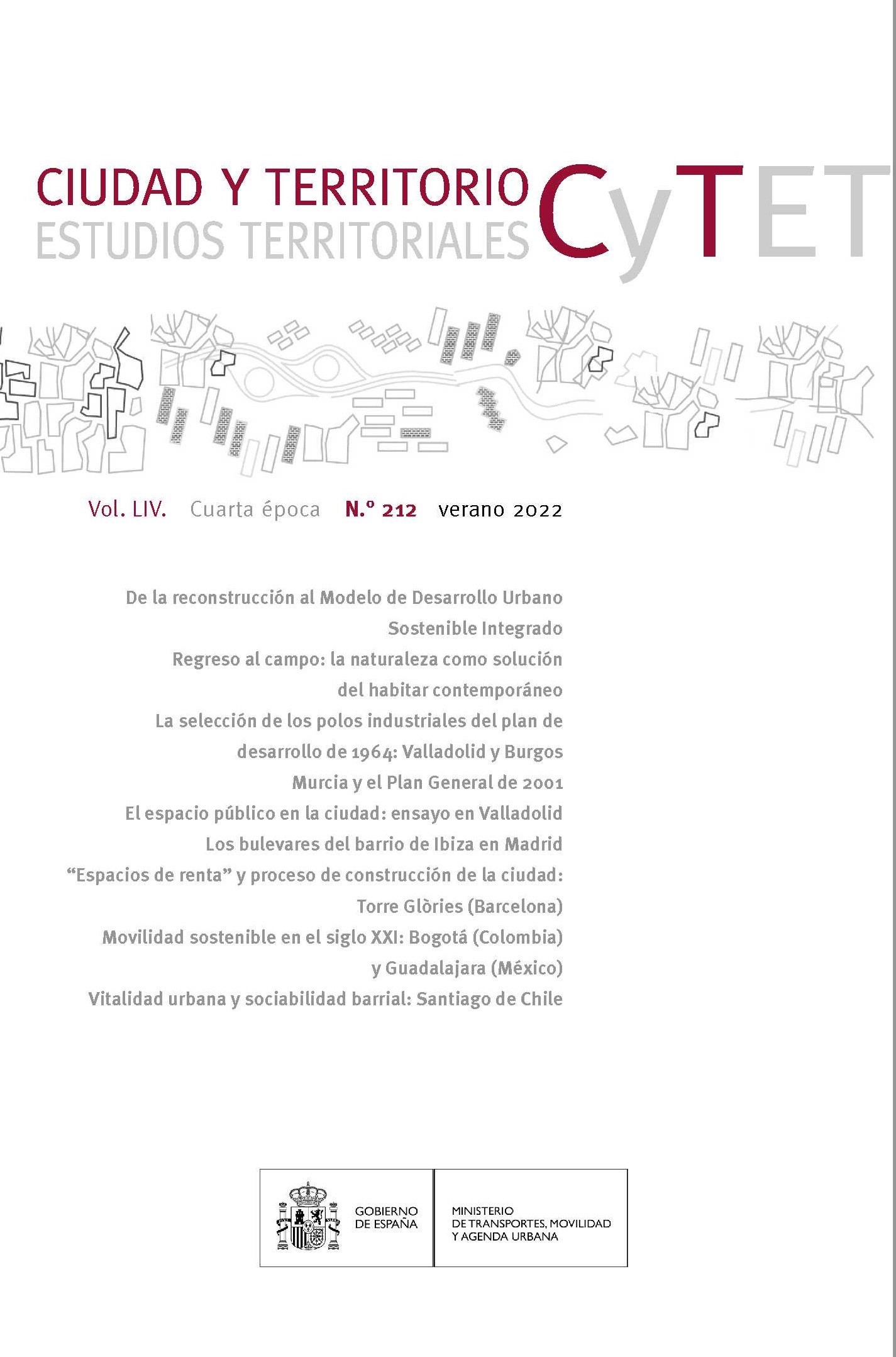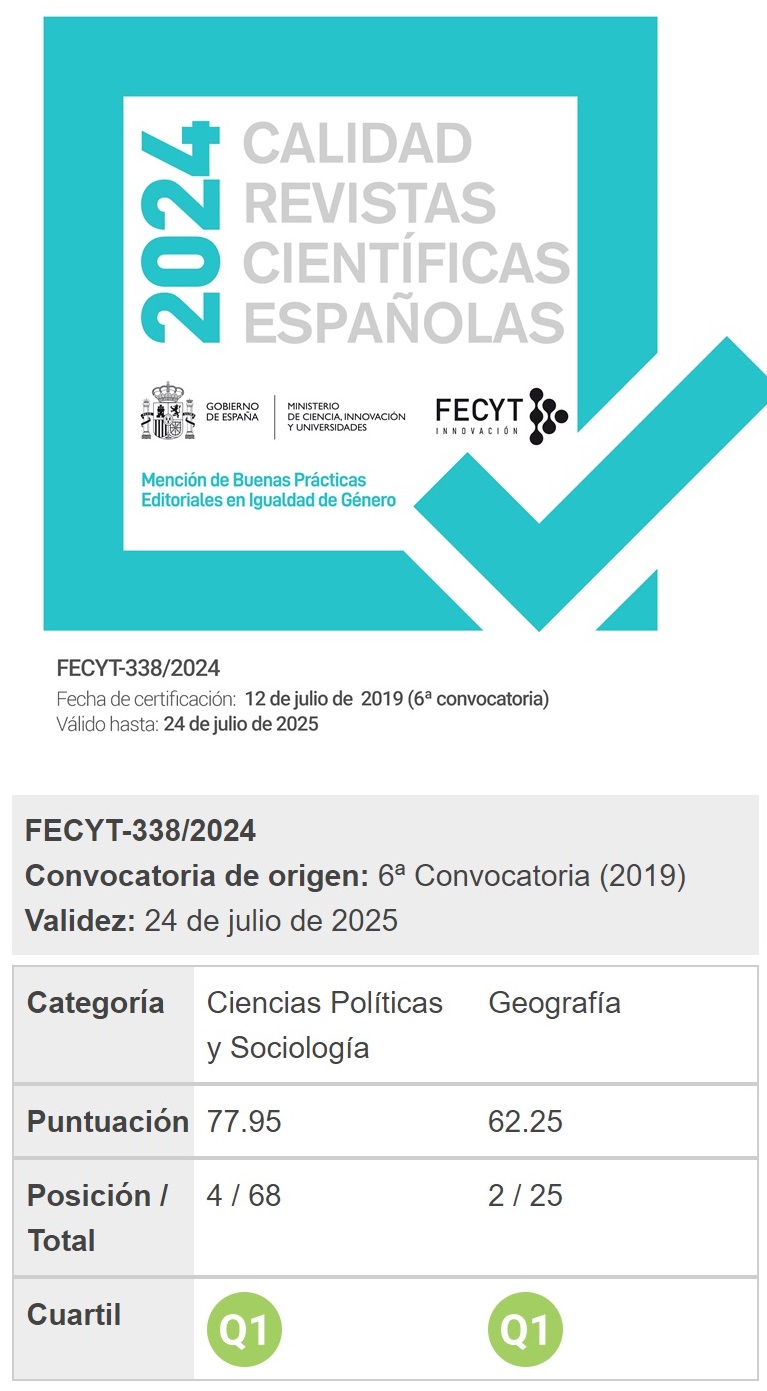Movilidad sostenible en el siglo XXI: prospectivas viales en Bogotá-Colombia y Guadalajara-México
DOI:
https://doi.org/10.37230/CyTET.2022.212.8Palabras clave:
Infraestructuras, Movilidad urbana, Siniestralidad, SostenibilidadResumen
La siniestralidad vial es un problema para los tomadores de decisiones en el sector público. Se prospecta que de continuar esta tendencia, para 2030 la mortandad por eventos viales se ubicaría como la quinta causa a nivel global. El objetivo de este estudio analiza el escenario de dos ciudades metropolitanas que han aplicado infraestructura vial encaminada a la sostenibilidad de la movilidad urbana. Para ello, se elaboró una escala de valoración cualitativa y por medio de estadísticas de siniestralidad vial se identificaron y compararon patrones de utilización de infraestructura peatonal, ciclista y transporte público masivo. Se prospecta que de seguir implementándose estas medidas, se tendría en las ciudades de Bogotá-Colombia y Guadalajara-México una reducción en las tasas de mortandad por siniestros viales superiores a un 30% en 2030.
Descargas
Citas
Alcaldía Mayor de Bogotá-Secretaría Distrital de Planeación de Bogotá (2014): Región metropolitana de Bogotá: una visión de la ocupación del suelo. http://www.sdp.gov.co/portal/page/portal/PortalSDP/actualidad-SDP-home/REGION-digital.pdf
Alcaldía Mayor de Bogotá-Defensoría del espacio público (2019): Reporte técnico de indicadores de espacio público.http://observatorio.dadep.gov.co/sites/default/files/2019/reporte_tecnico_de_indicadores_de_espacio_publico_2019_baja.pdf
Alcántara, E. (2010): Análisis de la movilidad urbana: espacio, medio ambiente y equidad. Colombia: CAF. https://scioteca.caf.com/handle/123456789/414
América Economía (2016): Rankin mejores ciudades para hacer negocios.https://www.americaeconomia.com/rankings
Adriazola, C & Duduta, N & Lindau, L. & Hidalgo, D. (2012): El transporte sostenible, bien hecho, también salva vidas. EMBARQ-Centro de Transporte Sostenible del Instituto de Recursos Mundiales WRI. Seminario Internacional de Investigación en Seguridad Vial-Universidad de los Andes, noviembre 19. Bogotá.https://sur.uniandes.edu.co/images/Presentaciones/SeminarioSeguridadVial/dario%20hidalgo.pdf
Asprilla, Y. (2016): La movilidad urbana sostenible: Un paradigma en construcción en el contexto del cambio climático. Revista Iberoamericana Universitaria en Ambiente, Sociedad y Sustentabilidad- AMBIENS Vol. 2, No 3. pp. 162-181. http://www.academia.edu/33759471/La_movilidad_urbana_sostenible_Un_paradigma_en_construcci%C3%B3n_en_el_contexto_del_cambio_clim%C3%A1tico
Asprilla, Y. & González, M. & García, F. (2018): Entropía en la periurbanización: desigualdad en el acceso a las infraestructuras de transportes en Tonalá, México. Urbe Revista Brasileira de Gestão Urbana, 10(3) 624-636. doi: https://doi.org/10.1590/2175-3369.010.003.AO10
Backhaus, G. (2009): Automobility: Global Warming as Symptomatology. Revista Sustainability No 1 pp. 187-208, USA. http://www.mdpi.com/2071-1050/1/2/187
Bannister, D. (2008): The sustainable mobility paradigm. Transport Policy, 15 (1) pp. 73-80, UK.
BID (2015): Ciclo-Inclusión en América Latina y el caribe, Guía para impulsar el uso de la Bicicleta.https://publications.iadb.org/es/ciclo-inclusion-en-america-latina-y-el-caribe-guia-para-impulsar-el-uso-de-la-bicicleta
Concejo de Bogotá (2020): Acuerdo 123 por el cual se aprueba el Plan Desarrollo Distrital 2020- 2024 “Un nuevo contrato social y ambiental para el siglo XXI”. http://www.sdp.gov.co/sites/default/files/edici_n_3001_pa_123_sd_ de_2020.pdf
CEPAJ (2020): Mortalidad por siniestros viales viales en Jalisco año 2014-2019.https://cepaj.jalisco.gob.mx/observatorio/accidentes-viales
Clapson, M. (2003): Suburban century, Social change and urban growth in England and the United State. New York: Oxford Bearg.
Díaz-Olariaga, Ó. (2020): Análisis urbano del próximo sistema multi-aeropuerto de la ciudad de Bogotá (Colombia). Ciudad Y Territorio Estudios Territoriales, 52(206). https://doi.org/10.37230/CyTET.2020.206.12
Duduta, N & Adriazola, C & Hidalgo, D. & Lindau, L (2014): Traffic safety on bus priority systems: Recommendations for integrating, safety into the planning, design, and operation of major bus routes. Washington D.C. EE. UU. WRI–CTSEmbarq.
European Commision (2017, January):Support study on data collection and analysis of active modes use and infrastructure in Europe, Final Report pp144 y Appendix C – Country Reports pp. 91 y 259. https://ecf.com/cycling-data/cycling-modal-share
European Commision (2018): Mobility and Transport. Anual Accident Repot. pp.86 https://ec.europa.eu/transport/road_safety/statistics-and-analysis/statistics-and-analysis-archive/annual-accident-report-archive_en
Gehl, J. (2014): Ciudades para la gente. Ciudad Autónoma de Buenos Aires-Argentina. Ediciones Infinito, 1ra. Edición, 280p.
García, F & González, M. & Asprilla, Y (2018): Determinación de los componentes entrópicos de la accidentalidad: el trinomio vehículo/usuario/camino en la metrópoli de Guadalajara, México. Tecnura, 22(55) pp. 51-65, doi: https://dx.doi.org/10.14483/22487638.13245
González, M. (2018): Entropy and negentropy of the particular electric vehicle in urban systems: homeostasis of mobility in México. DYNA, 85(206), 171-177. https://doi.org/10.15446/dyna.v85n206.72509
González, M. & Asprilla, Y. & Camarena, M. (2018): La construcción del paradigma de movilidad urbana sostenible: el reto metropolitano en México. Jalomo, F. y García, C. Ambientes Urbanos, Estudios territoriales y Construcción de nuevos paradigmas. Guadalajara – México. Ed. Universidad de Guadalajara, pp.145-171
Hiernaux, D. & Lindon, A. (2004): Desterritorialización y reterritorialización metropolitana: la Ciudad de México. Documents D'Anàlisi Geogràfica, 44, 71-88. https://ddd.uab.cat/pub/dag/02121573n44/02121573n44p71.pdf
Herce, M. (2009): Sobre la Movilidad en la Ciudad-Propuestas para recuperar un derecho ciudadano., Barcelona-España. Editorial Reverté.
INEGI (2015): Encuesta Intercensal. https://www.inegi.org.mx/programas/intercensal/2015/#Documentacion
ITDP (2012)::Planes Integrales de Movilidad, Lineamientos para una movilidad urbana sostenible, México, pp. 30-31
INML (2019): Cifras de Lesiones de Causa Externa en Colombia 2019. https://www.medicinalegal.gov.co/cifras-estadisticas/forensis
Johnston, I (2010): Beyond best practice road safety thinking and systems management: A case for culture change research. Safety Science (48)1 pp. 175–1181
Johansson, R. (2009): Vision Zero – Implementing a policy for traffic safety. Road Safety Division, Swedish Road Administration, Sweden.
Lefèvre, B. (2008)::Visión a largo plazo e interacciones “transporte-urbanismo”, los excluidos en el éxito del SBR TransMilenio de Bogotá. Ciudad Y Territorio Estudios Territoriales, 40(156), 321-343.https://recyt.fecyt.es/index.php/CyTET/article/view/75859
Mangosio, J. (2002): Investigación sobre Accidentes. Universidad Católica de Argentina.http://di002.edv.uniovi.es/~cueva/investigacion/lineas/simulacion/accidentes.pdf
Maxwell, S. (2001): Negotiations of Car Use in Everyday Life. En Miller, Daniel (Ed): Car Cultures. Oxford: Berg. London.
MIDE (2020): Viajes de pasajeros en el sistema Macrobús.https://mide.jalisco.gob.mx/mide/panelCiudadano/detalleIndicador/1358
Norton, P. (2015): Four Paradigms: Traffic Safety in the Twentieth-Century. United States Technology and Culture, supl. Special Issue: (Auto) Mobility, Accidents, and Danger; Baltimore 56.2, pp. 319-334
ONU (2015): Objetivos del desarrollo Sostenible 2015-2030”.https://www.un.org/sustainabledevelopment/es/cities/
ONU (2017): Nueva Agenda Urbana. https://onuhabitat.org.mx/index.php/la-nueva-agenda-urbana-en-espanol
ONU-HABITAT (2017): Nueva Agenda Urbana. Resolución ES/71/256. http://uploads.habitat3.org/hb3/NUA-Spanish.pdf
OMS (2015): Informe sobre la situación mundial de la seguridad vial.https://www.who.int/violence_injury_prevention/road_safety_status/2015/Summary_GSRRS2015_SPA.pdf
OMS (2018): Global status report on road safety 2018.https://www.who.int/violence_injury_prevention/road_safety_status/2018/en/
Pucher, J. & Buehler, R. (2010): Walking and Cycling for Healthy Cities. Journal Built Environment, Volume 36, (4): 391-414.
Rajan, S. (1996): The Enigma of Automobility. Pittsburgh. EE.UU. University of Pittsburgh Press.
SDM (2019): Encuesta de movilidad. https://www.movilidadbogota.gov.co/web/sites/default/files/Paginas/22-04-2020/20191216_presentacion_encuesta_v2.pdf
SEMOV (2017): Acumulada siniestralidad vial 2012 - 2017. http://semov.jalisco.gob.mx/estadistica
STCONAPRA, 2018): Informe sobre la situación de la seguridad vial México. https://www.gob.mx/salud/acciones-y-programas/secretariado-tecnico-del-consejo-nacional-para-la-prevencion-de-accidentes-102486?state=published
Sheller, M. & Urry, J. (2000): The City and the Car. International Journal of Urban and Regional Research. 24, pp. 737-757.
SITEUR (2020): ACTA 220 Consejo de administración, pasajeros Transportados. Sistema de Tren Eléctrico Urbano. http://siteur.gob.mx/files/transparencia/2020/ACTA_220.pdf
Tabasso, C. (2002): Paradigmas, teorías y modelos de la seguridad y la inseguridad vial.http://www.institutoivia.com/doc/tabasso_124.pdf
Transmilenio S.A (febrero, 2020): Estadísticas de oferta y demanda del Sistema Integrado de Transporte Público – SITP. https://www.transmilenio.gov.co/publicaciones/151672/estadisticas-de-oferta-y-demanda-del-sistema-integrado-de-transporte-publico-sitp-febrero-2020/
Publicado
Cómo citar
Número
Sección
Licencia
Derechos de autor 2022 YEFER ASPRILLA LARA, MARIO GUADALUPE GONZALEZ PEREZ, Darin Jairo Mosquera Palacios

Esta obra está bajo una licencia internacional Creative Commons Atribución-NoComercial-SinDerivadas 4.0.
Sin perjuicio de lo dispuesto en la legislación vigente sobre Propiedad Intelectual, y conforme a la misma, el/la los/las autor/a/es/as que publiquen en CyTET cede/n a título gratuito, de modo no exclusivo y sin límite temporal al Ministerio de Transportes, Movilidad y Agenda Urbana los derechos para difundir, reproducir, comunicar y distribuir en cualquier formato actual o futuro, en papel o electrónico, la versión original o derivada de su obra bajo licencia de Creative Commons Reconocimiento-NoComercial-SinObraDerivada 4.0 Internacional (CC BY-NC-ND 4.0), así como para incluir o ceder a terceros la inclusión de su contenido en índices, repositorios y bases de datos nacionales e internacionales, con referencia y reconocimiento en todo caso de la autoría del mismo.
Además, al realizar el envío, el/la los/las autor/a/es/as declara/n que se trata de un trabajo original en el que se reconocen las fuentes que han sido utilizadas en su estudio, comprometiéndose a respetar la evidencia científica y a no modificar los datos originales para verificar o refutar una hipótesis de partida; que el contenido esencial del mismo no ha sido publicado previamente ni se publicará en ninguna otra obra o revista mientras esté en proceso de evaluación en la revista CyTET; y que no se ha remitido simultáneamente a otra publicación.
Los autores deben firmar un Formulario de Cesión de Derechos, que les será enviado desde la Secretaría de CyTET una vez se acepte su artículo para ser publicado.
Con el objetivo de favorecer la difusión del conocimiento, CyTET se adhiere al movimiento de revistas de Open Access (OA) y entrega la totalidad de sus contenidos a diversos índices, repositorios y bases de datos nacionales e internacionales bajo este protocolo; por tanto, la remisión de un trabajo para ser publicado en la revista presupone la aceptación explícita por parte del autor/a de este método de distribución.
Se anima a las/os autoras/es a reproducir y alojar sus trabajos publicados en CyTET en repositorios institucionales, páginas web, etc. con la intención de contribuir a la mejora de la transferencia del conocimiento y de la citación de dichos trabajos.








 Enlace a CyTET en Linkedin
Enlace a CyTET en Linkedin